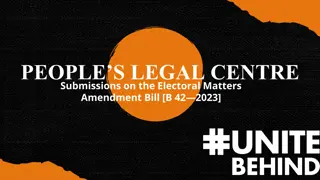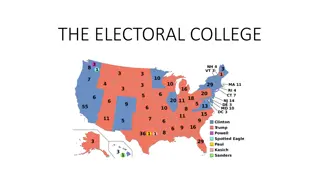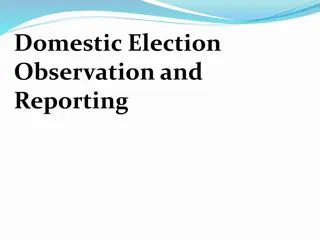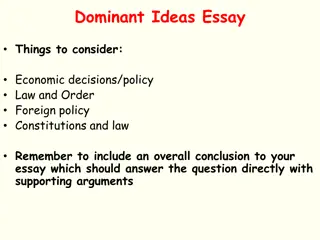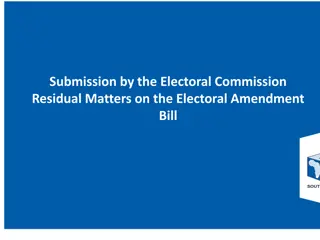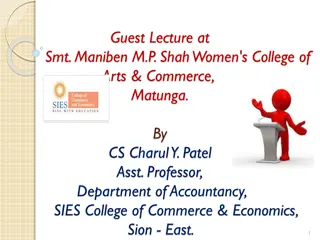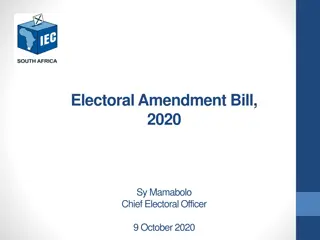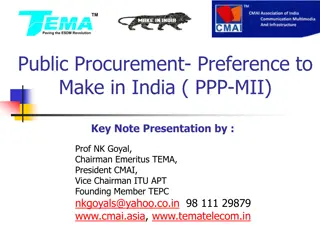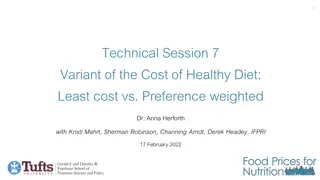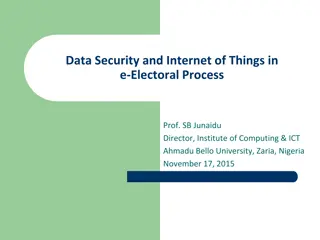Understanding Electoral Dynamics in Single-Peaked Preference Environments
Preferences in elections with single-peaked dimensions can lead parties to strategically position themselves towards the center to maximize votes. This process of moving towards the median voter is analyzed in a hypothetical scenario with bell curve distributions and random party positions. The equilibrium in such a competitive environment is examined, highlighting the dynamics of party strategies and voter behavior.
Uploaded on Jul 27, 2024 | 0 Views
Download Presentation

Please find below an Image/Link to download the presentation.
The content on the website is provided AS IS for your information and personal use only. It may not be sold, licensed, or shared on other websites without obtaining consent from the author. Download presentation by click this link. If you encounter any issues during the download, it is possible that the publisher has removed the file from their server.
E N D
Presentation Transcript
If everyone's preferences are single peaked on the same single dimension median voter theorem holds. Single dimension, e.g. left-right. Single-peaked each voter has an ideal point and the further away from the ideal point the lower their utility. Non single peaked voter Single peaked moderate voter Single peaked left voter Single peaked right voter Left Right
Aren'tallpreferences "single-peaked"? No Consider as example a wealthy parent. If spending on education is high, she sends her kids to public school. But otherwise she sends them to private school, and gets no benefit from education spending. So her preferences would look like this: #1 pick: high spending #2 pick: low spending #3 pick: medium spending Medium spending is her worst outcome she s paying more for a product she won t be (directly) consuming
Let's take these voters and put them in a hypothetical situation. Suppose we have a two-party (or two-candidate) election. Voters care about and are perfectly informed about party positions on exactly one issue: liberalism versus conservatism. The electoral rule is "winner-takes-all" - whoever gets more votes wins. When in doubt, assume ties are resolving by flipping a coin. Assumption about party/candidate motivation: They want to win, and care more about that than everything else put together. The two parties compete in exactly one way: By taking a stand on the issue. Imagine graphing the distribution of voter ideal points. There are many ways that it could look, but it is easiest - and pretty realistic - to draw it as a "bell curve."
Now suppose for a moment that each party's position is randomly assigned. Who votes for which party? The electorate may be divided into three groups: those who definitely vote for the more liberal party, those who definitely vote for the more conservative party, and the people in the middle, who pick whichever party is closer to them.
Now put yourself in the shoes of the party that will lose the election if it stays where it is. Question: What will it do to get more votes? Answer: Move to the center. They don't lose any of the extreme votes, and get more of the "swing" votes. you get the maximum possible number of votes by moving as close as possible to the rival party without overlapping. But then put yourself in the shoes of the rival party. It won't take this lying down. It will move towards the center as well. If necessary, it will "leap frog" over you. Standard economist's question thus emerges: What is the equilibrium?
You can't have an equilibrium where the parties' platforms are different, because both parties gain votes by moving closer to each other. You can't have an equilibrium where one party gets more than 50% of the votes. Why? Because you can always win 50% by simply offering exactly the same platform as your competitor. Thus, equilibrium platforms "converge" - both parties offer the same policy.
But what specific policy do they converge to? To answer this, recall that the medianof a distribution is the point with half of the distribution's density above it and half below it. What is the median in this series: {100, 7, 3, 1, 1} ? Could the equilibrium platform ever be one where both parties are above the median of the distribution of voter preferences? No. Why?Because one party would get more than 50% of the votes by moving a little closer to the median. Could the equilibrium platform ever be one where both parties are below the median of the distribution of voter preferences? No, for the same reason. Could the equilibrium platformbethe median of the distribution? Yes! If both parties are at the median, then staying there gets you 50% of the votes, but moving a little to the left or right gets youfewer than 50%.
Thus, we arrive at the famousMedian Voter Theorem: Given the preceding assumptions, both parties move to the exact median of the distribution of voter preferences. In other words, they both offer platforms identical to the bliss point of the median voter. Note: These results hold up as long as parties prefer winning to losing, all else equal.
Competing parties thus find themselves under intense pressure to cater to the median voter. But the identity of the median voter typically changes when the electorate changes. In a conservative state, for example, the median voter will be more conservative, and both parties will have to offer conservative policies to win. Similarly, if poorer voters are less likely to vote, parties will move to the median of the distribution of voters, not the distribution of citizens. There are many factors that affect participation: age, education, what's on the ballot... even the weather. Ifproportionalamounts of all political persuasions don't vote, the median stays the same, and so does the electoral outcome. But if participation changes in a disproportionate way, this changes the median, and thereby changes the nature of the winning platform.
There are also legal restrictions on voting. Non-citizens normally can't vote at all. Citizens have to register in advance to vote. Non-residents in a state can't vote in that state. Convicted felons and children can't vote. Similarly, you have to be a Supreme Court justice to vote in the Supreme Court, a U.S. Senator to vote in the U.S. Senate, etc. As you would expect, measures that come before these bodies are usually tailored to the median of those who vote on these measures.
The world used to be worse. Democracy is no different. In the past, there were often stronger restrictions on voting, also known as "restrictions of the franchise." 1. Non-property-holders 2. Non-whites 3. Women 4. 18-21 year-olds The motivation is simple: change the median voter to your preferred interests.
Corporations typically have voting, but it is voting proportional to your number of shares. (Turnout of small share-holders is also typically very low). Thus, the median corporate voter is usually a large shareholder with a big stake in the company's financial success. In the past, some countries (like Sweden) also had "plural voting," with extra votes for the aristocracy.
In many cases, we see people with extreme preferences deciding not to vote because "their" candidate is an unprincipled "sell-out." This is probably a major force that keeps real-world parties from completely converging. They have to trade-off extra moderate votes for foregone extremist votes. Fringe, "extremist" parties do much the same thing. For example, if a far-left Green Party exists, then the Democrats have to worry about two things: 1.Extremists stay home 2. Extremists vote Green How do fringe parties affect the outcome? They tend to push the median in the oppositeof the direction they favor! If the 5% of most-left-wing Democrats vote Green, the median of the remaining voters shifts to the right.
So what are fringe parties doing? In many cases, they say they are working for long- run attitudinal change. In the 2000 presidential election, fringe parties wound up making a huge difference in spite of their small vote shares. Will the Libertarian and Green Parties move the 2016 election?
The Median Voter Theorem only strictly holds if there is a single issue. If there are two or more issues that parties take stands on, but only one election, there is no guarantee that the median voter's preference will win onanyissue. Moreover, even with single-peaked preferences, multiple voting dimensions make it possible for voting cycles to arise. Chaos. At this point, you might say: "Butallreal-world elections have multiple issues. So the Median Voter Theorem is useless." Possibly so, but matters are more complicated than that. In particular, we will see that to a large extent, platforms empirically boil down to a single dimension - in the U.S., position on the liberal-conservative spectrum.


![RE: ELECTORAL MATTERS AMENDMENT BILL [ B42-2023]](/thumb/18837/re-electoral-matters-amendment-bill-b42-2023.jpg)


